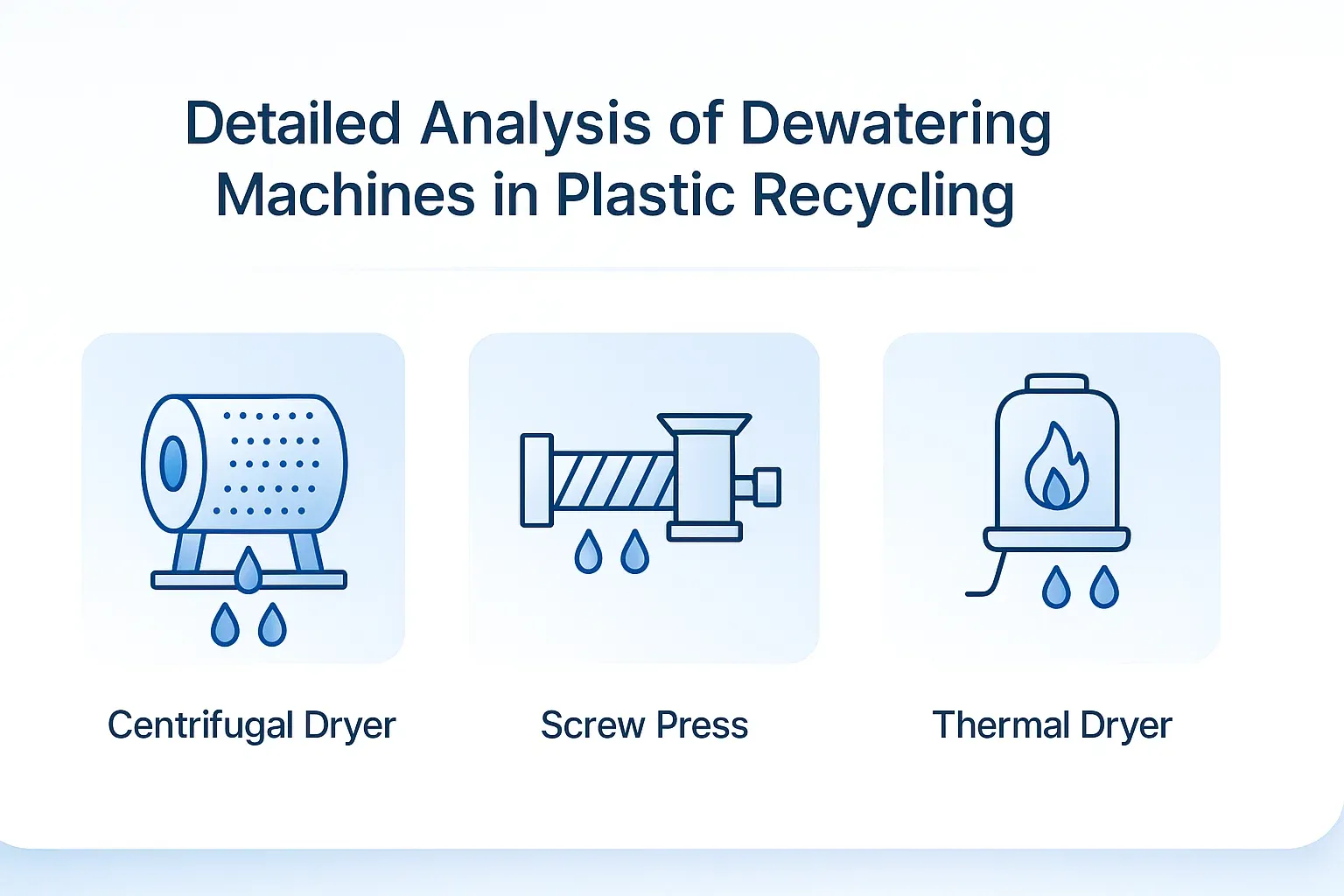Genbrug af plastik står som en hjørnesten i moderne bæredygtighedsinitiativer med det afgørende mål at minimere affald og på en genial måde genbruge materialer til nye, værdifulde produkter. Inden for de komplicerede faser af genbrugsprocessen, afvanding fremstår som et absolut afgørende skridt. Dets primære funktion er effektivt at fjerne vand fra vasket plast og omhyggeligt forberede det til efterfølgende, transformerende forarbejdning.
Denne artikel tilbyder en dybdegående undersøgelse af det uundværlige rolle, forskellige typer og betydelige fordele af afvandingsmaskiner inden for plastgenbrugslandskabet. Vi sigter mod at give værdifuld indsigt til branchefolk, der søger at optimere deres drift, og til miljøbevidste læsere, der er ivrige efter at forstå mekanismerne bag effektiv genbrug.
Forståelse af afvandingsmaskiner: De ubesungne helte inden for plastgenbrug
Afvandingsmaskiner er sofistikerede, specialiserede udstyrsdele, der er omhyggeligt konstrueret til at udvinde vand fra forskellige materialer. I forbindelse med plastgenbrug er deres primære funktion at fjerne overskydende fugt fra plast, der har gennemgået en grundig vask. Dette sikrer, at plasten er optimalt klar til afgørende downstream-processer såsom tørring, pelletering eller ekstruderingHvorfor er dette så vigtigt? For meget vand kan alvorligt kompromittere den samlede effektivitet af genbrugslinjen, potentielt skadesfølsomt udstyr længere nede, og kritisk, negativt påvirke kvaliteten og integriteten af det endelige produkt af genbrugsplast.
En typisk, velstruktureret proces til genbrug af plast omfatter generelt følgende nøglefaser:
1. Indsamling og sortering – Denne indledende fase involverer indsamling af plastaffald og derefter omhyggelig sortering af det efter type (f.eks. PET, HDPE, LDPE) og kvalitet, da forskellige plasttyper kræver forskellig forarbejdning.
2. Vask – Den sorterede plastik vaskes derefter grundigt for at fjerne forurenende stoffer såsom snavs, madrester, etiketter, klæbemidler og andre urenheder.
3. Afvanding – Eftervask, det er her vores fokus ligger. Afvandingsmaskiner arbejder for at udvinde så meget vand som mekanisk muligt fra det rensede plastmateriale.
4. Tørring – Selv efter afvanding kan der være restfugtighed tilbage. En efterfølgende tørringsfase reducerer dette fugtindhold yderligere for at opfylde strenge forarbejdningskrav.
5. Pelletering/Ekstrudering – Til sidst smeltes den rene, tørre plastik og omdannes til pellets (til senere brug) eller ekstruderes direkte til nye produkter, hvilket fuldender genbrugskredsløbet.
Brancheundersøgelser fremhæver konsekvent betydelig variation i fugtindholdet findes i vasket plast. For eksempel kan materialer som plastfilm indeholde op til 30% vand efter vægt, mens andre typer af stiv plast kan holde så meget som 70% fugtighed før afvandingstrinnetDet primære mål med afvandingsprocessen er at drastisk reducere dette fugtighedsniveau til et mere håndterbart interval, typisk mellem 5% og 30%, afhængigt af den specifikke type afvandingsmaskine og plastens art. Dette sikrer optimale forhold for de efterfølgende tørrings- og forarbejdningsfaser.
Typer af afvandingsmaskiner og deres mekanismer
Plastgenbrugsindustrien anvender adskillige forskellige afvandingsteknologier, der hver især tilbyder unikke fordele, der er skræddersyet til specifikke plasttyper, gennemløbskrav og driftsmæssige behov.
1. Centrifugalafvandingsmaskiner
Centrifugale afvandingsmaskiner, også kendt som centrifugaltørrere, udnytter kraften fra højhastighedsmaskiner snurrende kræfter til effektivt at uddrive vand fra plast. Når det våde plastmateriale føres ind i en hurtigt roterende tromle eller kurv, skubber centrifugalkraften vandet udad gennem en perforeret sigte, mens de afvandede plastfaststoffer tilbageholdes. De er særligt effektive til forarbejdning små plastflager, genkværnede partikler og plastikspåner, og findes almindeligvis i Genbrugsanlæg og -operationer for plastfilm, der håndterer stive plastflager.
• Vigtigste fordele: Høj driftseffektivitet, hurtig fugtreduktion, relativt kompakt størrelse.
• Fugtindhold efter afvanding: Typisk opnår 5-30% restfugtighed, afhængigt af materiale og maskinindstillinger.
• Anvendelse: Yderst velegnet til forskellige plasttyper, herunder PET-, HDPE-, LDPE- og PP-flager og -film.
2. Trintørrere
Trintørrere repræsenterer en mere specialiseret tilgang, der anvender en flertrins mekanisk afvandingsprocesDe har typisk en unik trinformet kurvskærm og en specialdesignet rotor der blidt tumler og transporterer materialet gennem forskellige zoner. Denne progressive handling udvinder gradvist vand. De er særligt effektive til genbrug tekniske termoplaster som polycarbonat (PC) og polypropylen (PP) hvor usædvanligt lave slutfugtighedsniveauer er afgørende for at opretholde materialets integritet.
• Vigtigste fordele: Kan opnå ultralave restfugtighedsniveauer (f.eks. 0,4% ned til imponerende 0,06 wt%), der sikrer genbrugsmateriale af exceptionelt høj kvalitet.
• Fugtindhold efter afvanding: Kan være så lav som 0.06%, hvilket reducerer behovet for termisk tørring betydeligt.
• Anvendelse: Ideel til Avancerede genbrugsoperationer, der kræver output af høj kvalitet, især for plast, der er følsomme over for hydrolyse.
3. Klemmemaskiner (skruepresser)
Klemmemaskiner, der ofte bruger en skruepressemekanisme, fjerner vand ved at anvende kontinuerlig mekanisk trykVådt plastmateriale føres ind i et kammer, hvor en roterende snegle transporterer og komprimerer det mod en perforeret si eller et begrænset udløb. Dette tryk presser effektivt vandet ud. De er yderst robuste og ideelle til store plastgenbrugsanlæg håndtering af store mængder. De er særligt effektive til afvanding fleksible materialer som plastfilm og blød plast, hvilket ofte reducerer fugtigheden til så lavt som 3% i nogle avancerede applikationer.
• Vigtigste fordele: Generelt energieffektiv sammenlignet med termisk tørring, i stand til at håndtere store kontinuerlige mængder, effektiv til materialer, der er vanskelige at afvande.
• Fugtindhold efter afvanding: Typisk 2-10%, i høj grad afhængig af den specifikke model, materialeegenskaber og driftsparametre.
• Anvendelse: Ekstremt effektiv til plastfilm (LDPE, LLDPE), landbrugsfilm, vævede poser og andre bløde plasttyper.
Hver type afvandingsmaskine præsenterer tydelige fordeleDet optimale valg afhænger af en omhyggelig evaluering af faktorer som den oprindelige og målrettede fugtindhold, den specifikke type plast, der behandles, og genbrugsanlæggets samlede kapacitet og økonomiske mål.
Vigtigste fordele ved afvandingsmaskiner i plastgenbrug
Integrationen af effektive afvandingsmaskiner i plastgenbrugsprocesser medfører en lang række betydelige fordele og optimerer hele processen:
1. Reduktion af materialets vægt og volumen
Ved effektivt at fjerne størstedelen af overskydende vand, kan afvandingsmaskiner reducerer både vægt og volumen betydeligt af det forarbejdede plastaffald. Denne reduktion har en direkte positiv indvirkning på logistikken, hvilket gør opbevaring og transport betydeligt mere håndterbar og omkostningseffektiv.
Eksempel på beregning:
• Overvej 1 ton (1.000 kg) tørt plastaffald der i starten holder 70% fugtighedsindholdDen samlede vægt af dette våde materiale er faktisk 1000 / (1 – 0,70) = ~3.333 kg (3,33 tons).
• Efter effektiv afvanding reduceres fugtindholdet til 20%, bliver den samlede vægt 1000 / (1 – 0,20) = 1.250 kg (1,25 tons).
• Dette repræsenterer en betydelig ~62,5% reduktion i totalvægt, hvilket fører til betydeligt lavere logistikomkostninger (brændstof, håndtering, køretøjskapacitet) og øget forarbejdningseffektivitet pr. batch.
2. Optimal forberedelse af plast til videre forarbejdning
For efterfølgende stadier som ekstrudering og pelletisering For at være effektiv og give resultater af høj kvalitet skal fugtindholdet i plastråmaterialet være minimalt. Overskydende vand kan forårsage en række problemer, herunder materielle fejl såsom hulrum, sølvstriber eller sprødhed i det færdige produkt. I alvorlige tilfælde kan det endda føre til dampeksplosioner i procesmaskiner, hvilket forårsager skader på dyrt udstyr ligesom ekstrudere. Afvanding sikrer, at plastikken er optimalt forberedt, hvilket minimerer disse risici.
3. Forbedring af kvaliteten af genbrugsplast
Genbrugsplast af højere kvalitet er et direkte resultat af effektiv afvandingVed at minimere restfugt kan producenten forhindre almindelige problemer såsom revner, vridning eller svækket strukturel integritet efter støbning i slutprodukterne. Denne forbedrede kvalitet er især vigtig for industrier, hvor præcise materialespecifikationer og ydeevnestandarder er ikke-forhandlingsbare, hvilket gør det muligt for genbrugsplast at konkurrere mere effektivt med jomfruelige materialer.
4. Opnåelse af betydelige omkostningsbesparelser og øget samlet effektivitet
Ved mekanisk at reducere fugtindholdet væsentligt, betydeligt mindre termisk energi er påkrævet for enhver efterfølgende (og ofte energikrævende) termisk tørring stadier. Dette oversættes direkte til lavere driftsomkostninger (f.eks. el- eller gasregninger). Derudover, som tidligere fremhævet, betyder lettere materiale lavere transportudgifter og giver ofte mulighed for højere gennemløb i downstream-udstyr.
Illustrativ casestudie:
• Et plastgenbrugsanlæg efter installation af et effektivt WEIMA C.200 skruepresse til afvanding af deres filmaffald, rapporterede besparelser på ca. 250 € om dagen udelukkende på omkostninger til transport og bortskaffelse på grund af materialets reducerede vægt og volumen.
• Den oprindelige investering i afvandingsudstyret tjente sig selv hjem inden for cirka et år, hvilket tydeligt demonstrerer det overbevisende økonomiske fordele implementering af effektiv afvandingsteknologi.
Udfordringer og vigtige overvejelser
Selvom det er yderst effektivt, er det vigtigt at erkende, at de fleste mekaniske afvandingsmaskiner muligvis ikke fjerner fuldstændigt al fugt fra plasten. Afhængigt af plasttypen, dens form (flager, film osv.) og den specifikke afvandingsteknologi, der anvendes, vil der være en vis restfugtighed tilbage. Dette nødvendiggør ofte en yderligere termisk tørringstrin for at opnå de ultralave fugtighedsniveauer, der kræves til visse anvendelser med høje specifikationer. Fugtighedsniveauerne efter afvanding kan variere betydeligt:
• CentrifugalafvandingsmaskinerTypisk forlader 5-30% restfugtighed.
• TrintørrerKan opnå usædvanligt lave niveauer, nogle gange så lavt som 0,06% fugtighed.
• Klemmemaskiner (skruepresser)Generelt resulterer det i 2-10% fugtighed, varierende med designets raffinement og det materiale, der forarbejdes.
Derfor, at vælge højre afvandingsmaskine, eller en kombination af afvandings- og tørringsteknologier, er absolut afgørende for at maksimere samlet behandlingseffektivitet, opnåelse af betydelige omkostningsbesparelser og sikring af den ønskede outputkvalitet af den genbrugte plastik.
Konklusion: Afvandingens uundværlige rolle
Afvandingsmaskiner er virkelig uundværlig komponenter i den moderne infrastruktur til plastgenbrug. De forbedrer betydeligt driftseffektivitet, slutproduktets kvalitet og den overordnede bæredygtighed af genbrugsprocessen. Ved effektivt at fjerne vand på et kritisk stadie hjælper de med at reducere driftsomkostninger, forbedre markedsværdien af genbrugsplast og aktivt støtte en grønnere og mere cirkulær økonomi.
For enhver organisation, der ønsker at optimere deres plastgenbrugsproces, investerer i det rigtige afvandingsmaskine er en strategisk beslutning, der kan give et betydeligt afkast, både hvad angår øget rentabilitet og positiv miljøpåvirkning.
Sammenligningstabel: Overblik over typer af afvandingsmaskiner
| Maskintype | Primær mekanisme | Vigtigste fordel(e) | Typisk fugt efter afvanding | Almindelig brug / Bedst til |
|---|---|---|---|---|
| Centrifugal afvanding | Højhastighedsrotation (centrifugalkraft) udstøder vand | Effektiv mod små partikler/flager, hurtig virkning | 5-30% | Diverse plasttyper (PET, HDPE, PP-flager), filmgenbrug |
| Trin tørretumblere | Flertrins mekanisk vandfjerning, blid tromling | Opnår ultralave fugtighedsniveauer og bevarer materialets integritet | 0.4-0.06% | Avanceret termoplast (PC, PP), krævende anvendelser |
| Klemmemaskine (skruepresse) | Mekanisk tryk- og kompressionsudtrækning | Håndterer store mængder, energieffektiv, robust | 2-10% (kan være lavere for film) | Plastfilm, blød plast, højkapacitetsoperationer |
Ved omhyggeligt at udvælge den mest passende afvandingsmaskine for deres specifikke behov kan genbrugsanlæg betydeligt optimere deres drift, reducere energiforbruget, skære ned på driftsomkostningerne og yde et mere væsentligt bidrag til en bæredygtig fremtid.



